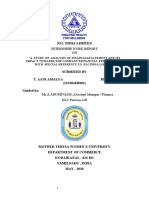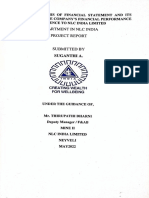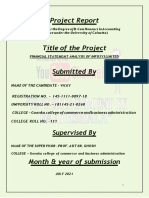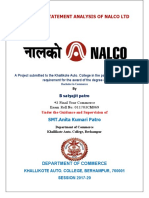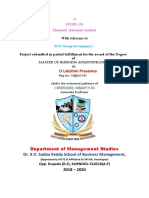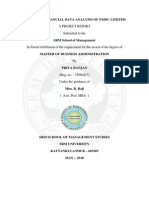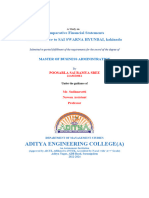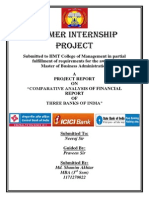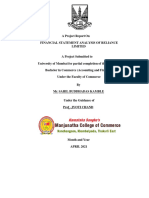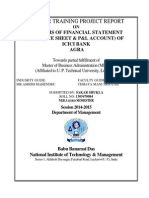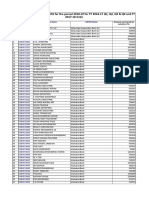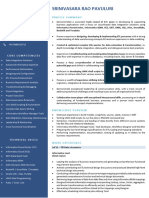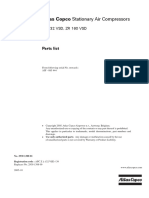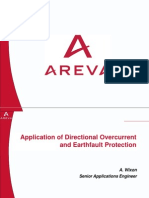INTERNSHIP WORK REPORT
ON
A STUDY ON ANALYSIS OF FINANCIAL STATEMENT AND ITS IMPACT
TOWARDS THE COMPANY FINANCIAL PERFORMANCE WITH
SPECIAL REFERENCE TO NLC INDIA LIMITED
SUBMITTED BY
C ANGELIN JENISHA ( Reg no:213304ER002)
Guided By
MR.A.ARUMUGAMASSISTANTMANAGER/FINANCE
NLC PENSION CELL
MOTHER TERESA WOMEN’S UNIVERSITY
DEPARTMENT OF COMMERCE
KODAIKANAL - 624 101
TAMILNADU , INDIA
MAY - 2022
I
�STUDY ON ANALYSIS OF FINANCIAL STATEMENT
AND ITS
IMPACT TOWARDS THE COMPANY'S FINANCIAL
PERFORMANCE
WITH SPECIAL REFERENCE TO
NLC INDIA LIMITED
DEPARTMENT IN NLC INDIA
INTERNSHIP REPORT
SUBMITTED BY
ANGELIN JENISHA .C
UNDER THE GUIDANCE OF
Mr.A.ARUMUGAM
Assistant Manager / Finance
NLC Pension cell
NLC INDIA LIMITED
NEYVELI
II
� MAY - 2022
NLC INDIA LIMITED
("NAVRATNA"- GOVERNMENT OF INDIA ENTERPRISE)
NEYVELI, TAMILNADU
BONAFIDE CERTIFICATE
Certified tha t the internship "A STUDY ON ANALYSIS OF FINANCIAL
STATEMENT AND ITS IMPACT TOWARDS THE COMPANY'S
FINANCIAL PER FOR MA NCE WITH SPE CIA L RE FE RE NCE TO NLC
INDIA LIMITED" is the Bonafide work of, Miss.ANGELIN JENISHA .C, (Reg no:
213304ER002) pursuing M.com (Integrated) fist year, a Internship work done during the
period from 23.05.2022 to 30.05.2022 at Finance & Accounts Branch, Mine-II, NLCIL
Neyveli. Their performance, conduct and attendance during the period were found to be good.
PLACE : NEYVELI
DATE : -05-2022
SIGNATURE OF GUIDE
III
� NLC INDIA LIMITED
"NAVRATNA"- A GOVERNMENT OF INDIA ENTERPRISES
NEYVELI-607 801 TAMILNADU
CERTIFICATE
This is to certify that this internship report on "A STUDY ON ANALYSIS OF
FINANCIAL STATEMENT AND ITS IMPACT TOWARDS THE COMPANY'S
FINANCIAL PERFORMANCE WITH SPECIAL REFERENCE TO NLC INDIA
LIMITED" is a Bonafide internship report work done by Miss. ANGELIN JENISHA .C,
(Reg. no: 213304ER002) pursuing M.com ( Integrated) Fist year, MOTHER TERESA
WOMEN’S UNIVERSITY, ATTUVAMPATTY, KODAIKANAL - 624 101 during the
period from 23.05.2022 to 30.05.2022 at Finance & Accounts Branch, Mine-II, NLCIL
Neyveli.
EXTERNAL GUIDE
Permitted to submit the internship work report to college/university authorities.
PLACE : NEYVELI
DATE :
DEPUTY CHIEF MANAGER/HR,
LEARNING AND DEVELOPMENT CENTRE,
NLC INDIA LIMITED, NEYVELI
IV
� DECLARATION
I hereby declared that the internship work entitled "A STUDY ON ANALYSIS OF
FINANCIAL STATEMENT AND ITS IMPACT TOWARDS THE COMPANY'S
FINANCIAL PERFORMANCE WITH SPECIAL REFERENCE TO NLC INDIA
LIMITED, NEYVELI", submitted to department of Commerce in
MOTHER TERESA WOMEN’S UNIVERSITY, ATTUVAMPATTY, KODAIKANAL
for the degree of Master of Commerce (Integrated) in a reward of
original work done by myself under the guidance of Mr. A. ARUMUGAM, Assistant
manager / Finance , NLC Pension cell, NLC IN DIA LIMIT D NEYV EL I .
This internship report is for reference only and no part of the report will be published of copied
anywhere without the written pe rmission from officia ls of NLCIL, Neyveli.
Signature of the student
(ANGELIN JENISHA .C)
V
� ACKNOWLEDGEMENT
I wish to thank the eminent personalities who served as a backbone for the
success of this internship apart from the efforts taken by me.
I express my sincere thanks to NLC - India Limited for providing me the
opportunity to carry out the internship.
I sincerely thank Shri. MATHEW KOSHYGM / L&D , Learning &
Development Centre , Dr. GANESH N DCM/HR , Mr. KALYANA SUNDRAM
J.E./E Learning & Development Centre for his kind patronage and for all the
facilities offered to do this internship successfully.
With deep sense of gratitude , I immensely thank my guide
Mr. A. ARUMUGAM, Assistant manager/ Finance , NLC Pension cell, for his
guidance and wonderful support to carry out this internship under his
effective supervision , guidance , encouragement and co- operation.
I would have never succeeded in completing my internship work without the
co-operation and technicians, and other personalities of Mine-II.
VI
� ABSTRACT
The main objective is to analyse the financial statement and its impact towards
the Company's financial performance with special reference to NLC INDIA
LIMITED. This present study was undertaken with an aim to underneath the
strength and weakness of the financial Performance in NLC INDIA LIMITED.
The assessment of an organization shows how efficient and stable was those
financial decisions by using the ratio analysis and Comparative balance sheet
statement. Thus it becomes a critical part of financial management. This study also
assesses the impact towards the company's financial performance . This lead us
to the topic of “ A STUDY ON ANALYSIS OF FINANCIAL STATEMENT
AND ITS IMPACT TOWARDS THE COMPANY'S FINANCIAL
PERFORMANCE WITH SPECIAL REFERENCE TO NLC INDIA”.
VII
� TABLE OF CONTENT
CHAPTER PARTICULARS PAGE N0
NO
1 INTRODUCTION
1.1Finance 1
1.2Importance of finance 1
1.3Financial statement analysis 1
1.4Definition 2
1.5 FINANCIAL TOOLS 2
1.6 Advantages of financial analysis 2
1.7 Scope of the study 3
1.8 Objective of the study 3
1.9 Financial performance 3
2 INTRODUCTION OF THE COMPANY
2.1 Introduction of the Industry 4
2.2 Company vission and mission 5
2.3 Company values 5
2.4 units of the com,pany 5
2.5 Strength of the company 6
2.6 Company Business 6
2.7 Oppourtunities 7
2.8Company threats 7
3 RESEARCH METHODOLOGY
3.2 Data collection 8
33 Financial tools used 9
3.3.1 Ratio analysis 11
3.3.2 Comparative balance sheet 12
DATA ANALYSIS AND 15-18
INTERPRETATION
4 CONCLUSIONN 19
REFERENCE 20
VIII
� CHAPTER 1
INTRODUCTION
1.1 FINANCE
Finance is the process of raising funds or capital for any kind of
expenditure.It is the process of channeling various funds in the form of
credit, loan or invested capital to those economic entities that most need
them or can put them to the most productive use.
1.2 IMPORTANCE OF FINANCE
Finance is the study of money and assets. It is intertwined but
not the same with economics .Finance activities take place in Financial
systems at various scopes,thus the can be roughly divided into
personal,corporate and public finance.In a financial instruments ,such as
currencies,loans,bonds,shares,options,futures,..etc.Assets can also be
banked,invested,and insured to maximize value and minimize loss.In
practice,risks are always present in any financial action and entities.
1.3 FINANCIAL STATEMENT ANALYSIS
Financial statement analysis is the process of analyzing a
company’s financial statements f decision -making purposes. External
stakeholders use it to understand the overall health of an organization as
well as to evaluate financial performance and business.These statements
include the income statement,balance sheet,statement of cash flows,notes
to accounts and a statement of changes in equity.
1
�1.4 DEFINITION OF FINANCE
Area of economics activity in which money is the basis of the
various embodiments, whether stock market investments,real
estate,industrial,constructions,agricultural development, so on and area of
the company in which we study the performance of capital markets and
supply and price of financial assets.It is defined by Simon Andrade.
1.5 FINANCIAL TOOLS
The following are the tools and techniques used for financial statement
analysis
Ratio Analysis
Comparative and balance sheet statement
Cash flow statement
1.6 ADVANTAGES OF FINANCIAL ANALYSIS
Real-Time Analyses.
Better Debt Management.
Optimizing Financial Performance and Compliance.
Cash Flow Management.
Reducing Risk Exposure
2
�1.7 SCOPE OF THE STUDY
The study aims to analyze the financial statement of NLC India
Limited for the past 5 years (from 2015-2016 to 2019-2020)
.
This study is based on analyzing the financial position of the
company by using various financial tools such as ratio analysis,
comparative balance sheet and cash flow statement.
This study will also help then management to take right financial
decisions in the future.
1.8 OBJECTIJVE OF THE STUDY
To analyze the financial strength and soundness of NLC India limited
over the period of 5 years.
To determine the liquidity position of the company based on the
financial turnover.
To analyze the financial weakness of NLC India limited.
1.9 FINANCIAL PERFORMANCE
Financial performance is a subjective measure of how well a firm
can use assets from its primary mode of business and generate revenues.
The term is also used as a general measure of a firm's overall financial
health over a given period.
3
� CHAPTER 2
INTRODUCTION OF THE COMPANY
2.1 .INTRODUCTION OF INDUSTRY
NLC India Ltd (NLCIL) formerly, Neyveli Lignite Corporation
Limited, a Navaratna enterprise of Government of India (GOI) is an
existing, profit making, public sector enterprise engaged in mining of
lignite and generation of power through lignite based thermal power
plants. NLCIL was established by GOI in 1956, following the discovery
of lignite deposits in Neyveli, Tamil Nadu.NLCIL comes under
administrative control of Ministry of Coal, GOI and serves as an
important source of power generation to the states of Tamil Nadu, Andhra
Pradesh, Karnataka, Kerala, Telangana, Rajasthan and Union Territory of
Puducherry.
NLC operates four opencast lignite mines of a total capacity of
30.6million tonnes per annum (MTPA) at Neyveli and Barsingsar;
Six lignite based pithead thermal power stations with an aggregate
capaciy of 3640 MW at Neyveli and Barsingsar; and a 1000 MW coal
based thermal power Station at Thoothukudi, Tamil Nadu through its
subsidiary, NLC Tamil Nadu Power Limited (NTPL), a joint venture
between NLC and TANGEDCO (equity participation in the ratio of
89:11). NLC recently commissioned a 1x500 MW unit at Neyveli
which is also Asias largest ignite fired boiler. NLC has also forayed into
renewable energy sector with commissioning of a 141 MW Solar Photo
Voltaic Power Plant including 1 MW rooftop project at Neyveli and a 51
MW wind energy plant at Kazhuneerkulam village of Tirunelveli district
in Tamil Nadu. The Company is also setting up 1209 MW Solar Power
Projects at Tirunelveli, Virudhunagar and Ramanathapuramdistricts of
Tamil Nadu, of which,300 MW have been commissioned. NLC is aiming
to achieve a total renewable energy capacity of 4251 MW. NLC has also
contributed significantly to the socio-economic development for more
than half a century.
4
�2.2 COMPANY VISSION
To emerge as a leading Mining and Power Company with Social
responsiveness accelerating Nation's growth.
2.3 COMPANY MISSION
Promoting adherence to value based culture.
Develop and sustain expertise in power and mining with focus on
growth and financial strength.
Encouraging/ creating an atmosphere of continual learning and
competency building
.
Devising/ Upgrading HR Systems to support organizational g
2.4 COMPANY VALUES
N - National Orientation
L - Learning and Development
C-Commitment for Excellence
2.4 VARIOUS UNITS OF THE COMPANY
Mine l Mine1A, Mine2
Thermal Power station I, EXPN, TPS2
Solar power plant
Wind Power
5
�2.5 STRENGTH OF THE COMPANY
Diversified energy portfolio of Fossil Fuel Mining, Thermal Power
Generation & Renewable Power.
Expertise in lignite & coal fired power station
Expertise in renewable power generation and power trading.
Experienced Management team with committed and experienced
work force.
Having Pit Head Power Stations
.
Availability of lignite, coal and water for power generation
.
Expertise in open-cast lignite mining with SME technology.
Strong capabilities for exploration, mine planning, Research
& Development.
Harmonious industrial relations.
Strong track record of growth and financial performance.
Expertise in ground water management.
2.6 COMPANY BUSINESS
NLCIL has been established to carry out the objectives specified in
the Memorandum & Articles of Association of the Company as amended
from time to time. The main activities of NLCIL are Lignite Mining and
Power Generation. The company has also diversified into generation of
renewable energy through Solar Power Generation and Wind
Power Generation. The Business portfolio of the company is asunder:
6
�1. LigniteMining
2. Thermal PowerGeneration
3. Solar EnergyGeneration
4. Wind PowerGeneration
2.7 OPPORTUNITIES:
Investment in promoting Green Energy.
Governnment of India's (Gol) commitment to improve the quality of
life of its citizens through higher electricity consumption.
Rise in the per capita consumption of power.
Trading ofPower in the Market.
Launch of 100 smart cities mission by Gol
2.8 Threats:
Delay in realization of dues from beneficiaries.
Challenges posed by Renewable energy to Thermal Power Generation.
Huge surrender of Power by the beneficiaries and consequently
under-utilization of Thermal and Mining Capacity.
Resistance from land owners for acquisition, demand for enhanced
compensation, demand for employment.
Necessity of pumping of water below the lignite seam for safe mining
leading to higher cost of production.
Higher cost for rehabilitation & resettlement measures for land
evictees.
7
� REVIEW OF LITERATURE
3.1. Ramachandran. R, Kandhakumar. P and
Kannadas. P (2019): This study deals with evaluation of financial
performance of Alangulam Primary Agriculture Co-operative credit
society. The researcher has used various tools to discuss the Liquidity,
Profitability, Efficiency and Leverage. The study is based on the
secondary data .e. annual reports of past 5 years. The author has used
regression analysis, comparative and common size statement analysis to
arrive at any conclusion.Finally it was advised that the institution should
motivate and impart knowledge about banking to their staff and to bring
new products and services to the customers.
3.2 Magdalene peter &Ravi Kumar. A (2018): The main
objective is to know the financial strength and weakness of PHILIPS
through Financial ratio analysis. It also aims to understand the software
used in the company and to know the shortcomings of the Philips. The
data used in the study involves primary data and secondary data. The
primary data is from the investigation and observation. Secondary data
are from the company manuals, company website and annual reports of
the company As a result the author has found that the gross profit ratio,
earnings per share, return on assets and interest coverage seems to be in
good position for the 5 year period of 2006-2010. The company is
suggested to declare the dividend due to the huge profits, proper
utilization of fixed assets.
3.3 Chaman kumar (2015): This study examines the financial
situation of the HDFC banks using comparative analysis for the period of
2005-2015. Profitability and leverage measures are analyzed to
assess the financial viability. The data used in the study are from
the secondary sources like annual reports, journals, articles, websites and
financial books. The main objective of the study to examine the impact of
Net interest Margin on the banks perfornmance, impact of tax burden and
tax efficiency ratio on profit, to examine the capital adequacy ratio and
8
�evaluate return on capital. The author has also used earnings per share
(EPS) and Dividend per share (DPS) analysis technique. As a result he
has found that the bank has had a dividend policy that balances the dual
objectives of appropriately.
3.4 Ayad Shaker Sultan (2013): The study analyses the
financial statement and attempts to measure the performance of Baghdad
Soft Drink Industry in terms of asset utilization and profitability. 'The
study is based on 10 years secondary data ie. Audited annual report for
the period 2004-2013 and other data published by Iraqi Stock Exchange.
The techniques used for such analyses were profit margin, return on asset,
and return on equity, capital turnover ratio and expenses ratio. The author
also used comparative balance sheet and income statement. Moreover the
study emphasizes the declining condition of profitability and performance
of the company. As a conclusion, the author indicated that given the
condition of the country, locations of the company where it is situated
and the population, the company is more likely to recover from the
inconvenience faced by the company as evidenced through its financial
report and might be able to earm reasonable profits in the years ahead.
The study also states that though there are various researches are carried
out, till date no effective model has been established which captures
maximum variations.
3.5 Matarazzo (2003) has explained that liquidity tells the firm's
degree of independence against the creditors and also tells about the
difficulties faced by the firm.
9
� CHAPTER 3
RESEARCH METHODOLOGY
Research methodology is the specific procedure or techniques
used to identify ,select,process and analyze information about a topic . In
a research paper , the methodology section allows the reader to critically
evaluate study’s over all validity and reliability.
3.1. RESEARCHDESIGN
The research design used in this project is Finance Analysis of
the company , which researcher has to use facts of the financial data in
the company and analyze all about the financial performance and
statement .
3.2. DATACOLLECTION
Secondary data: Secondary data is the data that have been already
collected by and read available from other sources.
.
Company balance shee
t
Company website
Books and Journals pertaining to the topic
3.3. FINANCIAL TOOLS
Ratio analysis
Comparative balance sheet
10
�3.3.1 RATIO ANALYSIS
1. Ratio
Ratio is a “mathematical expression” a comparison of two or more
numbers that indicates their sizes in relation to each .
2 .Ratio Analysis
Ratio Analysis is the comparison of the items in the
financial statements of a business.Ratio Analysis is used to evaluate a
number of issues with an entity, such as its liquidity, efficiency of
operations and profitability.
3. Functional classification
The following types of measures used in financial analysis:
Profitability ratios
Solvency ratios
Turnover ratios
A.Profitability ratios
Profitability ratio are a class of financial metrics that are used to
assess a business’s ability to generate earnings relative to its
revenue ,operating costs , balance sheet assets or shareholders’ equity
over time, using data from a specific point in time.
B.Solvency ratio
Solvency ratio are a key component of the financial analysis which
helps in determining whether a company has sufficient cash flow to
manage the debt obligations that are due. Solvency ratios are known as
leverage ratios.
11
�C.Turnover ratio
Turnover ratio represents the amount of assets or liabilities that a
company replaces in relation to its sales. Turnover ratio measures the
time it takes to collect an average amount of accounts receivable. It can
be impacted by the corporate policy, payment terms, the accuracy of
policy and a multitude of other factors.
3.3.2.Comparative balance sheet statement
A comparative balance sheet is a statement that shows the
financial position of an organization over different periods for which
comparison is made or required. The financial position is compared
with 2 or more periods to depict the trend , direction of change ,
analyze and take suitable actions.
A comparative balance sheet is a side -by -side comparison of
the entire balance sheet report of a current accounting period and a
previous accounting period.
.
Comparative statement presents the results of multiple accounting
periods separate columns
.
.Working Capital
Working capital refers to the excess of current assets over
liabilities. This helps a financial manager or a business owner to know
about the liquidity position of the business.
Changes in Long-Term Assets, Liabilities, and Capital
The next component that a financial manager or a business
owner needs to analyze is the change in the fixed assets, long-term
liabilities and capital of a business. This analysis helps each of the
stakeholders to understand the long-term financial position of a business.
Profitability
Working capital refers to the excess of current assets over liabilities.
This helps a financial manager or a business owner to know about the
liquidity position of the business.
12
� The following points should be studied when analyzing a
comparative balance sheet
1. The present financial and liquidity position (study working capital).
2. The financial position of the business in the long term.
13
�THE FORMAT OF A COMPARATIVE BALANCE SHEET
Comparative balance sheet as at …
Previous Current Absolute Percentage
Year (₹) Year (₹) Change change
Particulars
(increase of (increase of
decrease)(₹) decrease)(₹)
I.EQUITY AND LIABILITIES
1.Shareholders Funds
(a) Share capital
(i) Equity Capital …... …... …. …..
(ii) Preference share capital ….. …... …. …..
(b) Reserves and surplus
1. Non-current Liabilities ….. …... …. …..
(a) Long- term borrowings …... …... …. …..
(b) Long-term Provisions ….. …... ….. …..
2. Current Liabilities
(a) Short-term borrowings …... …... ….. …..
(b) Trade payable ….. …... ….. …..
(c) Other current liabilities ….. …... ….. …..
(d) Short-term Provisions
…... …... ….. …..
Total …. ….… ….…. …...
II.ASSETS
1.Non- current Assets
(a) Fixed Assets
(i) Tangible Assets
(ii) Intangible Assets …... ….… ….…. …...
(b) Non-current Investment …... ….… ….…. …...
(c) Long-term Loans and Advances …... ….… ….…. …..
2. Current Assets
(a) Current investments …... ….… ….….. …...
(b) Inventories …... ….… ….….. …...
(c) Trade Receivable
(d) Cash and Cash Equivalents …. ….… ….….. …...
(e) Short-term Loans and ….. ….… ….….. …...
Advances
(f) Other current Assets
….… ….… ….….. …...
Total
…. ….… ….…… …
14
� DATA INTERPRETATION
Ratio Analysis:
Table .1 Calculation of current ratio
Parameters 2015-2016 2016-2017 2017-2018 2018-2019 2019-2020
Current 8726.16 8708.76 10134.86 9033.41 10551.74
asset
Current 2548.23 4289.36 5749.40 8086.41 8694.74
liability
Current 3.42 2.03 1.76 1.11 1.21
ratio
Working note 01:
Current ratio=Current asset/Current liability
2016=8726.16/2548.23=3.42
2017=8708.76/4289.36=2.03
2018=10134.86/5749.40=1.76
2019=9033.41/8086.41=1.11
2020=10551.74/8694.74=1.21
Fig 1. shows the current ratio
Inference:
The above table shows that the currentratio was high in the period of 2015-2016 with 3.42%
and low in the period of 2018-2019 with 1.11%. At 2020 the current ratio tends to be
Creased as 1.21% than previous year. Here it shows that they are having enough curent
eIS to meet its current liabilities and as per industry standard they are properly utilising
Curent resources.
15
� Table 2. Calculation of liquid ratio
Parameters 2015-2016 2016-2017 2017-2018 2018-2019 2019-2020
Liquid asset 7448.69 6895.52 8445.96 7569.03 9227.19
Current 2548.23 4289.36 5749.40 8089.41 8694.74
liability
Liquid ratio 2.92 1.61 1.47 0.94 1.06
Working note 02:
Liquid ratio=Liquid asset/current liability
2016=7448.67/2548.23=2.92
2017=6895.52/4289.36=1.61
2018=8445.96/5749.40=1.47
2019=7569.03/8086.41=0.94
2020=9227.19/8694.74=1.06
Fig .2.shows the liquid ratio
Inference:
The above table shows that the liquidratio was high in the period of 2015-2016 with 2.92%
änd low in the period of 2018-2019 with 0.94%. At 2019-2020 the liquid ratio tends to be Ceased
as 1.06% than previous year. Here it shows that company is more conscious about s liquidity
position and they are utilising quick assets in a better manner to fulfil current abilities. Its trend
shows that company gradually increased inventories so for that reason quick asset ratio got
decreased.
16
� Table .3 Calculation of fixed asset ratio
Parameters 2015-2016 2016-2017 2017-2018 2018-2019 2019-2020
Fixed asset 12111.70 14739.69 17649.28 20537.87 22519.41
Long term 18634.29 17239.25 19384.87 20827.84 24009.67
ratio
Fixed asset 0.65 0.86 0.91 0.99 0.94
ratio
Working note 03:
Fixed asset ratio=Fixed asset/long term fund
2016=12111.70/18634.29=0.65
2017=14739.69/17239.25=0.86
2018=17649.28/19384.87=0.91
2019=20537.87/20827.84=0.99
2020=22519.41/24009.67=0.94
Fig .3 shows the fixed asset ratio
Infernce:
The above table shows that the fixed asset ratio was high in the period of 2018-2019 with
0.99% and low in the period of 2015-2016 with 0.65%. At 2019-2020 the current ratio tends to be
decreased as 0.94% than previous year. Here it shows that company utilising shareholders fund
and long term loans for application in fixed assets of the company and fixed asset ratio trend gives
a clear picture that they are utilising longterm funds for procurement of fixed assets.
17
� Table .4 Calculatio of propreitary ratio
Parameters 2015-2016 2016-2017 2017-2018 2018-2019 2019-2020
Shareholder 15486.64 12198.63 13334.58 12511.33 12639.51
fund
Total asset 23670.06 27509.38 32506.41 34682.34 39119.09
Proprietary 0.65 0.44 0.41 0.36 0.32
ratio
Working note 04:
Propreitary ratio=Shareholder fund/Total asset
2016=15486.64/23670.06=0.65
2017=12198.63/27509.38=0.44
2018=13334.58/32506.41=0.41
2019=12511.33/34682.34=0.36
2020=12639.51/39119.09=0.32
Fig .4 shows the propreitary ratio
Inference :
From the above table it is inferred that the proprietary ratio was high in the year 2015-2016
with 0.65% and low in the year2019-2020 with 0.32o. From the year 2019-2020 the Proprietary
ratiotends to be decreasedthan previous year. Here it shows that proprietary fund ulisedin fixed
assets with the rate of 0.5% and it gives clear picture that they are giving POnty to utilise long
term borrowings for fixed asset procurement.
18
�Table .1 Calculation of asset turnover ratio
Parameters 2015-2016 2016-2017 2017-2018 2018-2019 2019-2020
Net sales 6652.05 8672.84 8496.20 7145.92 7916.30
Total asset 23670.06 27509.38 32509.41 34682.34 39119.09
Asset 0.28 0.32 0.26 0.21 0.20
turnover
ratio
Working note 01:
Asset turnover ratio=Net sales/Total asset
2016=6652.05/23670.06=0.28
2017=8672.84/27509.38=0.32
2018=8496.20/32509.41=0.26
2019=7145.92/34682.34=0.21
2020=7916.30/39119.09=0.20
Fig .1 shows the Asset turnover ratio
Inference:
The above table shows that the asset turnover ratio was high in the period of 2016-2017 with 0.32%
and low in the period of 2019 2020 with 20%. Both 2019 and 2020 has slight changes. Here it shows
that total assets of the company is getting higher and net sales is gradually decreased for respective
previous years with eftect of less than 0.5% of total assets. So it ines that fixed assets are properly
utilised in those years.
19
�Table..2 Calculation ofworkingcapital turnover ratio
PARAMETERS 2015-2016 2016-2017 2017-2018 2018-2019 2019-2020
Net sales 6652.05 8672.84 8496.20 7145.92 7916.30
Working capital 6177.93 4419.40 4385.46 947 1857
Working capital 1.08 1.96 1.94 7.55 4.26
turnover ratio
Working note 02:
Working capital turnover ratio=Net sales/working capital
2016=6652.05/6177.93=1.08
2017=8672.84/4419.40=1.96
2018=8496.20/4385.46=1.94
2019=7145.92/947=7.55
2020=7916.30/1857=4.26
Fig.5.2 shows the working capital turnover ratio
Inference:
Ihe above table shows that the working capital turnover ratio was high in the period of
2018- 2019 with 7.55% and low in the period of 2015-2016 with 1.08%. At2019-2020 the
working capital turmover ratio tends to be decreased with previous year as 4.26%.here it
shows that working Capital is properly utilised for the company and total sales generation
Is much higher with respect to total assets of the company and the rate of working capital
ratio is increasing gradually respective previous years.
20
� CHAPTER 4
CONCLUSION
After analyzing the last five years financial data of NLC India Limited. I
concluded that NLCIL is one of the leading Mining and Power
Generation Company of Tamil nadu with a\various production capacity
and input (Lignite and Coal) and it is a self-solvent company with a
strong leading position in the power sector. Physical performance of NLC
India Limited, for production of Lignite, generating Power, shows always
increasing and record able growth. The Overall financial performance
was satisfactory, good and effective which helps the company to run for
long term. Almost all of the ratios of NLCIL's show that they are solvent
enough and it have the efficiency to grow further.
21
�REFERENCE
Financial Accounting Book (Paul S.K).
NLCIL Website.
NLC Limited reports.
22
